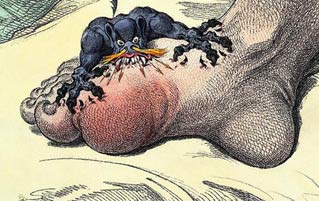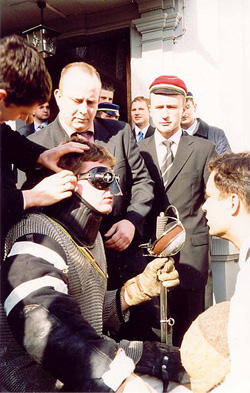5 Trends From History With Messed Up Explanations

Modern culture is nothing but a series of endless fads swirling around, chasing one another down the toilet of history. If only we could go back to the good old days, when life was simple, dignified, and important. Those people in your history books were busy doing things for you to read about in history books. They weren't subject to dumb fads. Theirs were ridiculous. There's a difference.
It's Cool To Not Give A Damn About Dying Horrifically
This is an ancient depiction of a king being murdered.

"Murder? Again? Seriously?"
Here's another:

"Though you may take my life, you will never take my complete apathy."
These are the result of a medieval obsession with Ars Moriendi, or the art of dying well. Medieval people were understandably preoccupied with death and the afterlife, since they were constantly dying of pretty much everything. But giving in to agony and allowing your face to contort into an outward reflection of one of the five temptations (disbelief, despair, impatience, pride, and avarice) was a sure way to find yourself bathed in eternal hellfire. On the other hand, displaying the calmness of Christ on the cross was a one-way ticket to the pearly gates.
Since the whole thing was about dying a Christly death, nobody was better at ignoring their own murder than the priesthood. Here's Saint Peter of Verona, for instance, who didn't even let a simultaneous chest-stabbing and head-splitting interrupt his prayer time:

"I'll be with you in a moment, giant cleaver."
And here's Saint Bartholomew, modeling his own skin like it's the hot new look from Pierre Cardin:

"Now give me 'Ugh, I'm SO over flailing as a torture method right now.'" *camera flash* *camera flash* "YES! Brilliant!" *camera flash*
The Nazis Firmly Believed That Chicks Dig Scars
This is Otto Skorzeny, poster boy of the German SS.

It wasn't a great poster.
You probably assumed he got that gnarly facial scar from an errant grenade or a Captain America haymaker, but it is in fact a souvenir from a centuries-old German tradition known as Mensur. Take an American fraternity hazing, replace the wooden paddles with swords, and (as one should always do with Nazis) swap the ass for the face, and you'd get the idea. A Mensur bout started with opponents donning protective gear -- leather chest guards, thick scarves, and, of course, bizarre steampunk goggles. Safety first!

"I just feel like I forgot something. My keys? Ah well, commence stabbing!"
While the tips of the swords were blunted enough to prevent outright murder, they were still capable of inflicting some truly nasty gashes. The aftermath of a Mensur match looked like the makeup room for The Walking Dead.

"This was fun. This is what fun is."
The horrific scars were considered badges of honor, even though bearing them implied that you lost so badly that you literally got your face rocked off. Strangely, though facial scars and Nazi officers go together like Nazi officers and impotence, the Third Reich actually outlawed Mensur when it came to power. But of course, if you outlaw something to protect idiots from themselves, all you're doing is making them feel like outlaws. Some fraternities still practice it to this day.

Here's a Polish frat member really, really hoping his scar looks "Tyrion from the Game Of Thrones show" cool,
and not "Tyrion from the books" terrible.
The Grecian Bend Made Hunchbacks Sexy (Again?)
In the mid 19th century, ladies' fashion took a turn that could cause Sir Mix-a-Lot to lose consciousness from sudden blood volume displacement.

Baby got back problems.
That's when the combination of corsets, bustles, crinolettes, and other bizarre woman-mutilating structures combined to form the sexiest hunchbacks this side of Marty Feldman. All this additional hardware forced the fashionable women of the day to walk with a stooped posture to keep from going ass over teakettle, and the resulting hunch became known as the "Grecian Bend." The term was originally coined during an earlier 19th-century craze, in which people attempted to ape the poses seen in the artwork of Ancient Greece.

Also known as the "Gotta Poop Gait."
It's not entirely relegated to history -- we still talk about the Grecian Bend today. See, during the construction of New York City's Brooklyn Bridge, workers traveled deep beneath the East River in specialized watertight metal tubes known as caissons. Traveling back up said tubes often resulted in decompression sickness. As construction workers watched their companions lurch around all hunched over, trying in vain to keep their own bodies from exploding, they obviously laughed and pointed out how this crippling pain made their friends look like those sexy upper-crust mutant ladies. Thus, decompression sickness became known as the Grecian Bend, later shortened to the bends.
Gout Was The Historical Version Of A MacBook

Gout was once known as Rich Man's Disease, because it's directly related to diet -- namely, the overindulgence in meats and wines and under-indulgence in fresh fruits and vegetables. This results in a buildup of uric acid in the blood, which soon affects the sufferer's joints. For most of history, only the wealthy could afford enough meat and wine for a bout of gout, and so it was regarded as a disease solely for kings and aristocrats. It was even seen as a "badge of genius," with famous minds such as Tennyson, Darwin, and even Michelangelo having suffered from the condition.

"What, you think I got these thunder thighs from exercise?"
Of course, in modern society, our diets have reversed. The wealthy can afford the freshest and healthiest food, while the poor survive entirely on deep-fried everything and hobo wine. Now gout is considered the Disease Of The Fat And Lazy, and history is seen as kind of an ironic dickhead.
Tuberculosis Was The Most Boneable Disease
Tuberculosis is a bacterial disease which causes victims to cough up bloody chunks of lung until they waste away into a pale, skeletal corpse. This is apparently sexy as all get-out.
In Renaissance times, pale skin was seen as highly attractive, because it meant that the pasty freak was so well-off that they never had to so much as step outside and see the awful, awful Sun. So following that logic, what could possibly be more attractive than the waxy and pallid complexion of a TB sufferer?

It's hard to tell due to the lack of color-based technology at the time, but this guy was Brad Pitt of the 1870s.
High-profile celebrities from John Keats to George Orwell to the Bronte sisters to esteemed gunslinger Doc Holliday succumbed to the disease, making it the "cool" way to go. Famous poet and esteemed sexpot Lord Byron once quipped that he "should like to die of a consumption," because that's the only way he could be hotter.
Looking beyond the obvious sex appeal of the visibly diseased, TB was also seen as a "clean" way to die. Its symptoms were clear and its progression predictable, giving you time to get your affairs in order before you hacked up your final gore-filled loogie. Stop, stop -- we can only get so aroused.
2016 is almost over. Yes the endless, rotten shit hurricane of a year which took away Bowie, Prince and Florence Henderson and gave us Trump, Harambe and the Zika virus is finally drawing to a close. So, to give this bitch a proper viking funeral, Jack O'Brien and the crew, which includes Dan O'Brien, Alex Schmidt, and comedian Caitlin Gill, are going to send out 2016 with Cracked's year in review in review. They'll rectify where every other year-in-review goes wrong by giving some much needed airtime to the positive stories from the 2016 and shedding light on the year's most important stories that got overlooked. Get your tickets here.
For more ways our forebearers were kind of really weird, check out 5 Bizarre Ways Our Ancestors Solved Major Crimes and 5 Reasons 'Traditional Marriage' Would Shock Your Ancestors.
Subscribe to our YouTube channel, and check out 4 Awful Ways Our Ancestors Got High (That We Tested!), and other videos you won't see on the site!
Follow us on Facebook, and we'll follow you everywhere.



